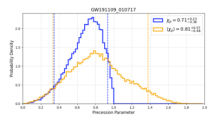
Abstract
Since the initial discovery of gravitational waves in 2015, significant developments have been made towards waveform interpretation and estimation of compact binary source parameters. We present herein an implementation of the generalized precession parameter ⟨χp⟩, which averages over all angular variations on the precession timescale, within the RIFT parameter estimation framework. Relative to the originally-proposed precession parameter χp, which characterizes the single largest dynamical spin in a binary, this new parameter ⟨χp⟩ has a unique domain 1<⟨χp⟩<2, which is exclusive to binaries with two precessing spins. After reviewing the physical differences between these two parameters, we describe how ⟨χp⟩ was implemented in RIFT and apply it to all 36 events from the second half of the Advanced LIGO and Advanced Virgo third operating run (O3b). In O3b, ten events show significant amounts of precession ⟨χp⟩>0.5. Of particular interest is GW191109_010717; we show it has a ∼28% probability that the originating system necessarily contains two misaligned spins.